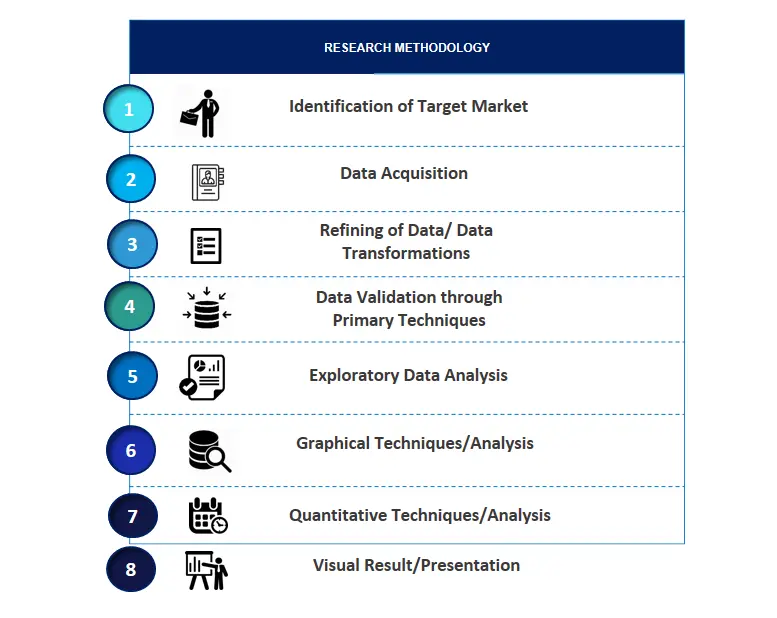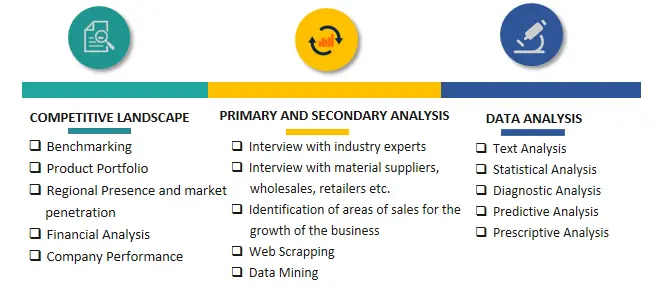
Artificial Intelligence in IVD Market Trends, Growth, Size, Analysis, Challenges, Future Outook
Artificial Intelligence in IVD Market Growth, Size, Trends Analysis - By Application, By Technology, By End User - Regional Outlook, Competitive Strategies and Segment Forecast to 2033
| Published: Jan-2025 | Report ID: MEDE2501 | Pages: 1 - 248 | Formats*: |
| Category : Medical Devices | |||
- Deep Bio, an AI healthcare business focused on deep learning and cancer pathology, took part in the CancerX initiative, a public-private partnership launched as part of the White House Cancer Moonshot program in November 2023. This strategic cooperation achieves milestones in its goal of applying AI expertise to revolutionize the landscape of cancer detection and prognosis.\
- In November 2023, China-based companies XtalPi and CK Life Sciences announced a collaboration agreement to create miRNA-based postoperative molecular diagnostic models for prognostic risk prediction. The firms will use XtalPi's superior artificial intelligence (AI) algorithms to evaluate anonymised clinical and biomarker data from cancer patients and healthy individuals stored in CK's repository.


| Report Metric | Details |
| Market size available for years | 2020-2033 |
| Base year considered | 2023 |
| Forecast period | 2024-2033 |
| Segments covered | By Application, By Technology, By End User |
| Regions covered | North America, Asia-Pacific, Latin America, Middle East & Africa and Europe |
| Companies Covered | Abbott, F. Hoffmann-La Roche Ltd, Siemens Healthineers AG, Thermo Fisher Scientific Inc, Danaher Corporation (Beckman Coulter), Sysmex Corporation, BioMerieux, Shenzhen Mindray Bio-Medical Electronics Co, Cardinal Health, PerkinElmer. |
- Pathology laboratories
- Diagnostic centers
- Clinics and specialty centers
- Public health laboratories
- Healthcare professionals (pathologists, radiologists, medical technologists, etc.)
- IVD manufacturers
- AI solution providers
- Healthcare IT providers
- Pharmaceutical and biotechnology companies
| By Application: | |
| By Technology: | |
| By End User: |
- Global Artificial Intelligence in IVD Market Size (FY’2024-FY’2033)
- Overview of Global Artificial Intelligence in IVD Market
- Segmentation of Global Artificial Intelligence in IVD Market By Application (Oncology, Infectious Disease, Cardiology, Other Applications)
- Segmentation of Global Artificial Intelligence in IVD Market By Technology (Machine Learning, Deep Learning, Other Technologies)
- Segmentation of Global Artificial Intelligence in IVD Market By End User (Hospitals and Clinics, Diagnostic Laboratories, Other End Users)
- Statistical Snap of Global Artificial Intelligence in IVD Market
- Expansion Analysis of Global Artificial Intelligence in IVD Market
- Problems and Obstacles in Global Artificial Intelligence in IVD Market
- Competitive Landscape in the Global Artificial Intelligence in IVD Market
- Impact of COVID-19 and Demonetization on Global Artificial Intelligence in IVD Market
- Details on Current Investment in Global Artificial Intelligence in IVD Market
- Competitive Analysis of Global Artificial Intelligence in IVD Market
- Prominent Players in the Global Artificial Intelligence in IVD Market
- SWOT Analysis of Global Artificial Intelligence in IVD Market
- Global Artificial Intelligence in IVD Market Future Outlook and Projections (FY’2024-FY’2033)
- Recommendations from Analyst
1.1. Scope of the report1.2. Market segment analysis
2.1. Research data source2.1.1. Secondary Data2.1.2. Primary Data2.1.3. SPER’s internal database2.1.4. Premium insight from KOL’s2.2. Market size estimation2.2.1. Top-down and Bottom-up approach2.3. Data triangulation
4.1. Driver, Restraint, Opportunity and Challenges analysis
4.1.1. Drivers4.1.2. Restraints4.1.3. Opportunities4.1.4. Challenges
4.2. COVID-19 Impacts of the Global Artificial Intelligence in IVD Market.
5.1. SWOT Analysis5.1.1. Strengths5.1.2. Weaknesses5.1.3. Opportunities5.1.4. Threats5.2. PESTEL Analysis5.2.1. Political Landscape5.2.2. Economic Landscape5.2.3. Social Landscape5.2.4. Technological Landscape5.2.5. Environmental Landscape5.2.6. Legal Landscape5.3. PORTER’s Five Forces5.3.1. Bargaining power of suppliers5.3.2. Bargaining power of buyers5.3.3. Threat of Substitute5.3.4. Threat of new entrant5.3.5. Competitive rivalry5.4. Heat Map Analysis
6.1. Global Artificial Intelligence in IVD Market Manufacturing Base Distribution, Sales Area, Product Type6.2. Mergers & Acquisitions, Partnerships, Product Launch, and Collaboration in Global Artificial Intelligence in IVD Market
7.1. Global Artificial Intelligence in IVD Market Size, Share and Forecast, By Application, 2020-20267.2. Global Artificial Intelligence in IVD Market Size, Share and Forecast, By Application, 2027-20337.3. Oncology7.4. Infectious Disease7.5. Cardiology7.6. Other Applications
8.1. Global Artificial Intelligence in IVD Market Size, Share and Forecast, By Technology, 2020-20268.2. Global Artificial Intelligence in IVD Market Size, Share and Forecast, By Technology, 2027-20338.3. Machine Learning8.4. Deep Learning8.5. Other Technologies
9.1. Global Artificial Intelligence in IVD Market Size, Share and Forecast, By End User, 2020-20269.2. Global Artificial Intelligence in IVD Market Size, Share and Forecast, By End User, 2027-20339.3. Hospitals and Clinics9.4. Diagnostic Laboratories9.5. Other End Users
10.1. Global Artificial Intelligence in IVD Market Size and Market Share
11.1. Global Artificial Intelligence in IVD Market Size and Market Share By Region (2020-2026)11.2. Global Artificial Intelligence in IVD Market Size and Market Share By Region (2027-2033)11.3. Asia-Pacific11.3.1. Australia11.3.2. China11.3.3. India11.3.4. Japan11.3.5. South Korea11.3.6. Rest of Asia-Pacific11.4. Europe11.4.1. France11.4.2. Germany11.4.3. Italy11.4.4. Spain11.4.5. United Kingdom11.4.6. Rest of Europe11.5. Middle East and Africa11.5.1. Kingdom of Saudi Arabia11.5.2. United Arab Emirates11.5.3. Qatar11.5.4. South Africa11.5.5. Egypt11.5.6. Morocco11.5.7. Nigeria11.6. North America11.5.8. Rest of Middle-East and Africa11.6.1. Canada11.6.2. Mexico11.6.3. United States11.7. Latin America11.7.1. Argentina11.7.2. Brazil11.7.3. Rest of Latin America
12.1. Abbott12.1.1. Company details12.1.2. Financial outlook12.1.3. Product summary12.1.4. Recent developments12.2. F. Hoffmann-La Roche Ltd12.2.1. Company details12.2.2. Financial outlook12.2.3. Product summary12.2.4. Recent developments12.3. Siemens Healthineers AG12.3.1. Company details12.3.2. Financial outlook12.3.3. Product summary12.3.4. Recent developments12.4. Thermo Fisher Scientific Inc12.4.1. Company details12.4.2. Financial outlook12.4.3. Product summary12.4.4. Recent developments12.5. Danaher Corporation12.5.1. Company details12.5.2. Financial outlook12.5.3. Product summary12.5.4. Recent developments12.6. Sysmex Corporation12.6.1. Company details12.6.2. Financial outlook12.6.3. Product summary12.6.4. Recent developments
12.7. BioMerieux
12.7.1. Company details12.7.2. Financial outlook12.7.3. Product summary12.7.4. Recent developments12.8. Shenzhen Mindray Bio-Medical Electronics Co12.8.1. Company details12.8.2. Financial outlook12.8.3. Product summary12.8.4. Recent developments12.9. Cardinal Health12.9.1. Company details12.9.2. Financial outlook12.9.3. Product summary12.9.4. Recent developments12.10. PerkinElmer12.10.1. Company details12.10.2. Financial outlook12.10.3. Product summary12.10.4. Recent developments12.11. Others
SPER Market Research’s methodology uses great emphasis on primary research to ensure that the market intelligence insights are up to date, reliable and accurate. Primary interviews are done with players involved in each phase of a supply chain to analyze the market forecasting. The secondary research method is used to help you fully understand how the future markets and the spending patterns look likes.
The report is based on in-depth qualitative and quantitative analysis of the Product Market. The quantitative analysis involves the application of various projection and sampling techniques. The qualitative analysis involves primary interviews, surveys, and vendor briefings. The data gathered as a result of these processes are validated through experts opinion. Our research methodology entails an ideal mixture of primary and secondary initiatives.



Frequently Asked Questions About This Report
PLACE AN ORDER
Year End Discount
Sample Report
Pre-Purchase Inquiry
NEED CUSTOMIZATION?
Request CustomizationCALL OR EMAIL US
100% Secure Payment






Related Reports
Our Global Clients
Our data-driven insights have influenced the strategy of 200+ reputed companies across the globe.






















